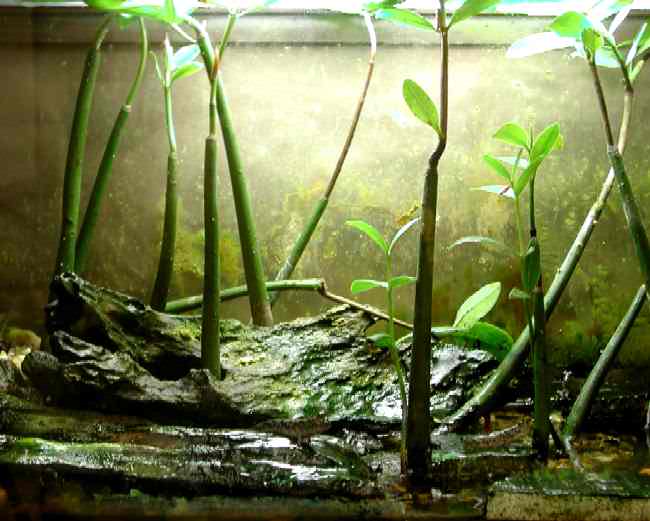BIOTOPE: Lothian Island Wildlife Sanctuary, West Bengal
Description: Lothian Island Wildlife Sanctuary is a magneficient island, having an area of 38 sq.km. This sanctuary is one of the wildlife sanctuary of Sunderban. Lothian Island was declared as Wild Life Sanctuary in June, 1976. It is one of the three Wildlife Sanctuaries of the Sundarban Biosphere Reserve. It is a part of deltaic Sunderbans which harbour a tropical estuarine swamp forest.
BIOTOPE INFORMATION
pH: 7.3-8.9,
15-25 dH,
75-97 F (24-36`C)
Brackish water specific gravity of 1.005-1.010 is present [Pure water has a sp. gr of 1.000, while seawater has around 1.025].
FLORA :
The tropical estuarine swamp forest consists of mangrove vegetation. Principal tree species are Keora, Baen, goran etc. The vegetation provides a dense cover throughout the habitat. Along the edge of the rivers there are grassy patches. Pretty much all mangrove seedlings grow above water - Phoenix paludosa, Excoecaria agallocha, Heritiera fomes, Bruguiera parviflora, etc.
TANK : The tank should have a sandy or clayey substrate. Use wood to recreate the mangrove roots of the swamp.
leave the tank only half full with water (i.e. paludarium type setup). A silty land area is constructed and potted mangrove seedlings grow above the water surface. Such a set-up allows an aquariast to observe unusual behaviour from brackish species such as mudskippers and certain crabs.
The animals found are Chital, Wild Pigs and Rhesus monkey. Jungle Cats are sighted occasionally. Birds are numerous including the migrants that visit the Sanctuary in winter. The marshes of the island harbour estuarine Crocodile. A lot of fishes specially of the gobiidae family are native to place. Also eels and certain oddballs are also open as an option. Fishes like Indian-dwarf mudskipper (Periopthalmus
novemradiatus), Duckbill sleeper (Butis butis), Ocellated pufferfish (Tetraodon cutcutia), Indian mottled eel (Anguila bengalensis), Tank goby (Glossogobius giuris), Bleeding Heart Goby (Gobiopterus chuno), Neon Spot Goby (Amoya brevirostris), etc. It is also reported that the Parioglossus winterbottomi is an exquisite species of the mini dartfish is also found in the waters here. Also oddball enthusiats will surely enjoy fishes like chaca chaca, Acentrogobius viridipunctatus are found here.
novemradiatus), Duckbill sleeper (Butis butis), Ocellated pufferfish (Tetraodon cutcutia), Indian mottled eel (Anguila bengalensis), Tank goby (Glossogobius giuris), Bleeding Heart Goby (Gobiopterus chuno), Neon Spot Goby (Amoya brevirostris), etc. It is also reported that the Parioglossus winterbottomi is an exquisite species of the mini dartfish is also found in the waters here. Also oddball enthusiats will surely enjoy fishes like chaca chaca, Acentrogobius viridipunctatus are found here.






No comments:
Post a Comment